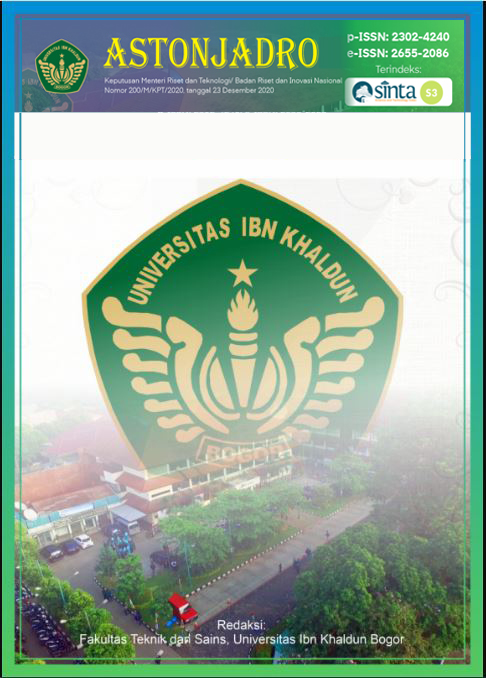Community of Analysis Mitigation and Adaptation to the Flood Disaster Overload of Lake Tempe, Wajo Regency
DOI:
https://doi.org/10.32832/astonjadro.v12i1.8143Keywords:
disaster mitigation, adaptation, purposive sampling, Lake Tempe.Abstract
In South Sulawesi, Wajo Regency is one of the areas prone to flooding during the rainy season. Floods that occur in the area cause inundation. The inundation that occurred was caused by the overflow of Lake Tempe. This research was conducted in Laelo Village, Tempe District, which is located around the Tempe Lake Coast. This location was chosen purposively with the consideration that the area has become a frequent flood in the western part of the kelurahan (the part near the lake). The village has a low contour in the west and high in the east. The research design is descriptive and qualitative which aims to describe the state or status of the phenomenon. The purpose of the research is to analyze the forms of adaptation and mitigation that will be carried out by communities in flood-affected areas. This research uses field surveys, in-depth interviews, making field notes, and documentation. The data collection method was carried out using purposive sampling because the desired sample in the study was only people living in the coastal area of the lake, namely in Laelo Village which was only affected by flooding, not the entire Laelo Village community. Data analysis techniques in qualitative descriptive research are carried out with interactive analysis in the form of cycles. Data analysis was carried out simultaneously with the implementation process of data collection. The results of interviews with the community show that they understand that flooding is an ordinary natural phenomenon which is an overflow of a lake, but they do not know why there is a flood. Some people who live on the shores of the lake feel that almost every year they are exposed to floods from the lake. Where the form of adaptation they do is to raise the pole of the house and prepare a boat that is moored under the house to be used as a means of transportation in the event of a flood. Several forms of mitigation that have been carried out are water hyacinth retaining embankments, and making taller bridges with concrete connecting roads from house to house. Information has been found regarding evacuation signs with the evacuation route installed, the mosque is used as a place to disseminate information related to the incident and development of the flood. It is better to form a disaster-resilient village in the area to create an area that is more prepared to face disasters.
References
Ali, M. and Trisutomo, S. 2017. ‘Pemetaan Daerah Rawan Banjir Berbasis Sistem Informasi Geografis (Gis) Di Pesisir Danau Tempe Kabupaten Wajo', LOSARI"¯: Jurnal Arsitektur Kota dan Pemukiman, (1), pp. 37–42. doi: 10.33096/losari.v2i2.57.
Arie S Priambodo. 2009. Panduan Praktis Menghadapi bencana.kansius
Astawa, K. E. A. 2019. ‘Adaptasi Masyarakat dalam Menghadapi Bencana Banjir di Desa Bambe Kecamatan Driyorejo Kabupaten Gresik'. Available at: http://digilib.uinsby.ac.id/34855/.
Bayuadi, M. Widad, Wiwik Setyaningsih, and Yosafat Winarto. 2019. Penerapan Konsep Mitigasi Struktural Pada Bangunan Museum Di Pesisir Pantai Watukarung. Senthong 2(2):489–98.
Bissett Jr, W., Huston, C., & Navarre, C. B. (2018). Preparation and Response for Flooding Events in Beef Cattle. Veterinary Clinics of North America: Food Animal Practice, 34(2), 309-324.
Benson, Charlotte, John Twigg. 2007. Perangkat untuk Mengarusutamakan Pengurangan Resiko Bencana: Catatan Panduan bagi Lembaga-Lembaga yang Bergerak dalam Bidang Pembangunan. Yogyakarta: Cyrcle Indonesia.
Faturahman, B, M. 2018. Konseptualisasi Mitigasi Bencana Melalui Perspektif Kebijakan Publik. Publisia: Jurnal Ilmu Administrasi Publik 3:122–34.
Hassani, W. F. 2014. Analisis Resiko Bencana Banjir di Kecamatan Majalaya Kabupaten Bandung. Universitas Pendidikan Indonesia.
Haque, c. e., & burton, i. (2005). adaptation options strategies for hazards and vulnerability mitigation: an international perspective, dalam buku mitigation of natural hazards and disasters: international perspectives. netherlands: springer.
Kiedrzynska, E., Kiedrzynski, M., & Zalewski, M. (2014). Sustainable floodplain management for flood prevention and water quality improvement. Journal of Natural Hazards, 76, 955–977.
Mcbean, g. a. (2005). risk mitigation strategies for tornadoes in the context of climate change and development, dalam buku mitigation of natural hazards and disasters:international perspectives. netherlands: springer.
Mileti, d. s., & gailus, j. l. (2005). sustainable development and hazards mitigation in the united states: disasters by design, dalam buku mitigation of natural hazards and disasters:international perspectives. netherlands: springer.
Nurjanah,dkk. 2012. Manajemen Bencana. Bandung: ALFABETA
Rahman, Z.A. 2015. Kajian Mitigasi Bencana Tanah Longsor Di Kabupaten Banjarnegara. Gema Publica. Jurnal Manajemen dan Kebijakan Publik. Vl. 1, No.1. ISSN 2460-9714
Sutopo. 2002. Metodologi Penelitian Kualitatif, Surakarta: Sebelas Maret University Press
Zakky. 2020. Pengertian Mitigasi Bencana Dan Contohnya (Struktural & Non-Struktural). Https://Www.Zonareferensi.Com/Pengertian-Mitigasi/.
Downloads
Published
How to Cite
Issue
Section
License
Copyright (c) 2022 ASTONJADRO

This work is licensed under a Creative Commons Attribution-ShareAlike 4.0 International License.
Paper submitted to ASTONJADRO is the sole property of the Astonjadro Journal. Unless the author withdraws the paper because he does not want to be published in this journal. The publication rights are in the journal Astonjadro.ASTONJADRO
LICENSE
This work is licensed under a Creative Commons Attribution-ShareAlike 4.0 International License.
Based on a work at http://ejournal.uika-bogor.ac.id/index.php/ASTONJADRO













